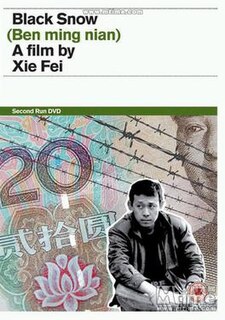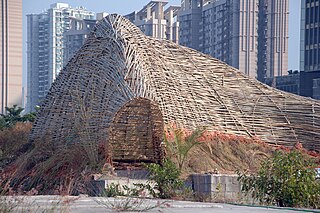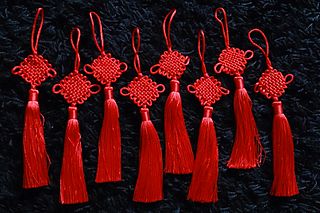 W
WThe arts of China have varied throughout its ancient history, divided into periods by the ruling dynasties of China and changing technology, but still containing a high degree of continuity. Different forms of art have been influenced by great philosophers, teachers, religious figures and even political leaders. The arrival of Buddhism and modern Western influence produced especially large changes. Chinese art encompasses fine arts, folk arts and performance arts.
 W
W798 Art Zone, or Dashanzi Art District, is a complex of 50-year-old decommissioned military factory buildings boasting a unique architectural style that houses a thriving artistic community in Dashanzi, Chaoyang District of Beijing. The area is often called the 798 Art District or Factory 798 although technically, Factory #798 is only one of several structures inside the complex formerly known as 718 Joint Factory. The buildings are within alleys number 2 and 4 on Jiǔxiānqiáo Lù (酒仙桥路), south of the Dàshānziqiáo flyover (大山子桥). The area is anchored by the UCCA Center for Contemporary Art, the largest and most visited venue in the area. In recent years, it has been the main venue for the annual Beijing Queer Film Festival and Beijing Design Week.
 W
WIn Chinese poetry, a couplet is a pair of lines of poetry which adhere to certain rules. Outside of poems, they are usually seen on the sides of doors leading to people's homes or as hanging scrolls in an interior. Although often called antithetical couplet, they can better be described as a written form of counterpoint. The two lines have a one-to-one correspondence in their metrical length, and each pair of characters must have certain corresponding properties. A couplet is ideally profound yet concise, using one character per word in the style of Classical Chinese. A special, widely seen type of couplet is the spring couplet, used as a New Year's decoration that expresses happiness and hopeful thoughts for the coming year.
 W
WBlack Snow is a 1990 Chinese drama film directed by Xie Fei. It was written and adapted from a novel by Liu Heng. It was entered into the 40th Berlin International Film Festival, where it won the Silver Bear for an outstanding single achievement. Although the English film title follows the original name of the novel, the Chinese film title 本命年 běnmìngnián means the year when someone is aged 12, 24, 36, and so on when the Twelve Terrestrial Branches come round again.
 W
WBug Dome was a bamboo shelter created for the Shenzhen & Hong Kong bi-city Biennale of Urbanism/Architecture in Shenzhen 2009, China by a group of architects calling themselves WEAK!
 W
WThe forms of Chinese furniture evolved along three distinct lineages which dates back to 1000 BC, based on frame and panel, yoke and rack and bamboo construction techniques. Chinese home furniture evolved independently of Western furniture into many similar forms including chairs, tables, stools, cupboards, cabinets, beds and sofas. Until about the 10th century CE the Chinese sat on mats or low platforms using low tables, in typical Asian style, but then gradually moved to using high tables with chairs.
 W
WChinese knotting is a decorative handcraft art that began as a form of Chinese folk art in the Tang and Song dynasty in China. The technique was later popularized in the Ming dynasty and subsequently spread to Japan, Korea, Singapore and other parts of Asia. This art is also called "Chinese traditional decorative knots". In other cultures, it is known as "decorative knots".
 W
WChinese painting is one of the oldest continuous artistic traditions in the world. Painting in the traditional style is known today in Chinese as guó huà, meaning "national painting" or "native painting", as opposed to Western styles of art which became popular in China in the 20th century. It is also called danqing. Traditional painting involves essentially the same techniques as calligraphy and is done with a brush dipped in black ink or coloured pigments; oils are not used. As with calligraphy, the most popular materials on which paintings are made are paper and silk. The finished work can be mounted on scrolls, such as hanging scrolls or handscrolls. Traditional painting can also be done on album sheets, walls, lacquerware, folding screens, and other media.
 W
WChinese ceramics show a continuous development since pre-dynastic times and are one of the most significant forms of Chinese art and ceramics globally. The first pottery was made during the Palaeolithic era. Chinese ceramics range from construction materials such as bricks and tiles, to hand-built pottery vessels fired in bonfires or kilns, to the sophisticated Chinese porcelain wares made for the imperial court and for export. Porcelain was a Chinese invention and is so identified with China that it is still called "china" in everyday English usage.
 W
WThe cinema of mainland China is one of three distinct historical threads of Chinese-language cinema together with the cinema of Hong Kong and the cinema of Taiwan.
 W
WDance in China is a highly varied art form, consisting of many modern and traditional dance genres. The dances cover a wide range, from folk dances to performances in opera and ballet, and may be used in public celebrations, rituals and ceremonies. There are also 56 officially recognized ethnic groups in China, and each ethnic minority group in China also has its own folk dances. Outside of China, the best known Chinese dances today are the Dragon dance and the Lion dance.
 W
WThe Fahai Temple is Ming Dynasty Buddhist temple located at the foot of Cuiwei Mountain, about two kilometers to the north-east of Moshikou, Shijingshan District, Beijing, China. It was declared as a national cultural relic protection unit in 1988. It is located within Fahai Temple Forest Park.
 W
WChinese folk art are artistic forms inherited from a regional or ethnic scene in China. Usually there are some variation between provinces. Individual folk arts have a long history, and many traditions are still practiced today. The general definition of folk art incorporates Chinese art forms that are not classified as Chinese fine art.
 W
WChinese patchwork is a traditional form of Chinese needlework which has been widely circulated in Chinese folk arts. In China, patchwork has been used for millennia.
 W
WA hanging scroll is one of the many traditional ways to display and exhibit East Asian painting and calligraphy. The hanging scroll was displayed in a room for appreciation; it is to be distinguished from the handscroll, which was narrower and designed to be viewed flat on a table in sections and then stored away again.
 W
WLào zi or Tāo zi is an ancient appellation in China refers to knotting craft. In ancient literature, the words Lào zi is actually Chinese knotting, however, the name of Chinese knotting is summarised by Lydia Chen in 1980s. The two of the words "Lào zi" and "Tāo zi" means the same in many case, Lào is specific meaning of knotting, enmeshing, and wrapping; and Tāo means lace or flat ribbon woven from silk thread that can decorate clothing.
 W
WLianhuanhua is a type of palm-size picture books of sequential drawings popular in China in the 20th century. It influenced modern manhua.
 W
WThe art of paper cutting in China may date back to the second century CE, since paper was invented by Cai Lun in the Eastern Han Dynasty in China. As paper became more affordable, paper-cutting became one of the most important types of Chinese folk art. Later, this art form spread to other parts of the world, with different regions adopting their own cultural styles. Because the cut-outs are often used to decorate doors and windows, they are sometimes referred to as chuāng huā (窗花), window flowers or window paper-cuts. People glued the papercuts to the exterior of windows, so the light from the inside would shine through the negative space of the cutout. Usually, the artworks are made of red paper, as red is associated with festivities and happiness in Chinese culture, but other colours were also used. Normally paper-cutting artwork is used on festivals like Spring Festival, weddings and childbirth. Papercuts always symbolize luck and happiness.
 W
WChinese paper folding, or zhezhi (摺紙), is the art of paper folding that originated in medieval China.
 W
WRoot carving is a traditional Chinese art form. It consists of carving and polishing tree roots into various artistic creations.
 W
WWhite Deer Plain is a 2011 Chinese drama film directed by Wang Quan'an and based on the novel of the same name by Chen Zhongshi. The film competed in competition for the Golden Bear at the 62nd Berlin International Film Festival, where Lutz Reitemeier was awarded a Silver Bear for Outstanding Artistic Contribution (Photography).